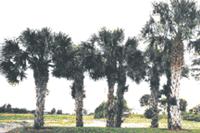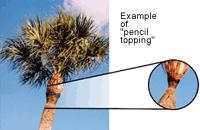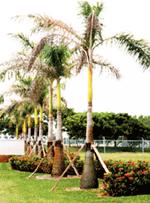Introduction
To think of Florida without imagining palm lined beaches, pink flamingos, and blue water is difficult. Palms trees are synonymous with our semi-tropical climate. This page will help you learn the basic needs of these tropical treasures.
Palm Selection:
Look at neighborhood palms and see which ones seem to thrive in your area. Take advantage of the many local nurseries within Broward County where you can see the many varieties of palms available. In most cases you can select and tag the palm that will be delivered to your property. Finally, you might go to one of your County Library Branches and look at a Florida Landscape Plants reference guide. You can obtain many ideas for Species selection and placement that could save you much time and effort.
Lethal Yellowing susceptibility of many of Florida's palms makes it prudent to select a resistant species. This disease causes the bloom to turn black and the immature fruit to drop, followed by the yellowing of fronds from the lower to the upper areas, culminating in bud rot and subsequent death. Lethal Yellowing is transferred by the insect plant hopper or leafhopper (Myndus crudus). Manila palms and many varieties of the Coconut palm are particularly vulnerable to this disease.
Native palms are generally more resistant. These include Sabal palm, Royal palm, Paurotis palm, Florida Thatch palm and Key Thatch palms. Non- native resistant palms include Alexander, Queen, Washingtonia, Maypan Coconut, and other species. Further information about resistant palms can be obtained from the Broward County Cooperative Extension Service.
Planting:
Location: Look at the proposed location and visualize the palm as full grown. Look up to see if there is clearance from buildings and overhead obstructions. A Royal Palm may grow into power lines rapidly. Another example would be the planting of Coconut Palms within a parking lot or thin highway median strips. Tell your nursery professionals where you will be planting the palm and they will be able to help with the particular requirements for each palm species.
Depth: Plant at the same height as grown except when the roots are exposed. In this case they should be planted with the soil level one half inch higher than the lower edge of the trunk. Use clean sand next to the trunk.
Soil: Palms do not like to be planted in heavy muck or clay soils since these soils hold too much water. They do well in sand and gravel-sand soils where water drains quickly. The perfect soil would be a sandy soil with 10 to 20 percent muck or peat to hold the water and provide nutrients. If the palm must be planted in rock or compacted marl/clay soil, then the hole around the root ball should be filled with a sandy peat replacement soil which is mounded in a low hill 6 inches above grade and 6 feet in width.
Initial Fertilization: Blend in fertilizer at the time of planting to enrich the soil removed from the hole. The mixing rate of two ounces of palm fertilizer per inch of trunk diameter (measured at ground level) should be sufficient. After watering and settling in the tree, one additional ounce of slow release palm fertilizer per three inches of trunk on the ground will get the tree off to a good start.
Watering In: Water-in a new palm as you plant it. "Rock" the ball gently to remove all trapped air in the new hole. Working in the soil around the root ball as it is watered-in with a shovel or rod is also very helpful. This is most important when planting large palms and helps avoid compaction of the root zone area.
Watering For Healthy Establishment: Water a newly planted palm at least twice a week for the first six months. Add enough water to insure a moisture penetration of a foot and a half (18 inches). Sandy soil requires more watering to maintain the moisture.
Established Palms:
Fertilization: Established palms should be fertilized with a slow release palm fertilizer a minimum of twice per year; four applications are better. A palm fertilizer in the form of slow release pellets and contains roughly 8 to 9 percent Nitrogen, 2 to 3 percent Phosphorus, 11 to 12 percent Potassium plus trace elements. Because palms are highly prone to several potentially fatal micronutrient deficiencies, any fertilizer applied to them should contain 1-2% Iron and Manganese, plus trace amounts of Zinc, Copper, and Boron to prevent these deficiencies. This is commercially available with NPK ratios of (12-4-12) or (8-2-12). The application rate for established palms is eight ounces (half pound) per inch of trunk diameter.

Water: During dry periods, soak the base of the tree with an open hose at least twice a month.
Pruning Palm Trees:
Avoid pruning trees whenever possible. Most palms shed their fronds naturally, but others drop the fronds after some time. When it is necessary to prune the trees, never remove fronds that do not hang below a line parallel to the ground. The hurricane or candle cut pruning of palms is a violation of Broward County Code and is subject to enforcement action. As palms recycle nutrients from the browning fronds to the heart of the palm (translocation of nutrients), frond removal deprives the tree of needed nutrients and weakens its defenses against invasive molds and fungi. Allowing self-pruning or self-cleaning is especially important for species that have a 'crown shaft' which is a green column below the fronds. Additionally, repeated hurricane cuts produce a condition known as "penciling" which is the narrowing of the palm trunk just below the fronds. Hurricane winds may snap off the top of the palm where the thinning has occurred allowing the top of the palm to become airborne.

For trees without crown shafts, prune fronds by sawing them off close to the trunk after they have turned brown. Broward County Code states that pruning of live palm fronds that initiate above the horizontal plane is considered tree abuse. This means that the "Hurricane Cut" or "Candle Cut" is not only harmful to the palm, but in most cases are Broward County Code violations. Code violations can result in fines, tree removal and tree replacement. Never pull or rip off fronds. Permanent wounds to the trunk can occur allowing for fungus or rot invasion and produces ever-enlarging holes in the trunk. The only time a "Hurricane Cut" is permissible is in regards to newly installed palms and palms to be relocated, as this cut reduces evapotranspiration rates (water loss) and aids palm tree survival and establishment in these circumstances. Removing green fruit and seeds with pruning saws, does not hurt the palm and keeps the ground clear. The blooming stalk can be removed as soon as it appears.
Mulching:
Palms benefit from an 18 inch layer of mulch applied at least six inches away from the trunk and 2 to 6 inches thick. Use commercial sterilized mulch. Freshly ground tree mulch can contain the organism responsible for the lethal disease 'Ganoderma Butt Rot.' Dead Palm trees containing the deadly fungus 'Ganoderma zonatrum,' can be ground up into a fine looking but lethal mulch. Tools used in removing dead trees should be sterilized with rubbing alcohol (isopropyl alcohol) or hydrogen peroxide (H2O2), to prevent transferal of the fungus.

More Important Palm Information
- Puncture Wounds Never Heal!
- Do not use nails or screws to attach lights or signs to the trunk of any palm tree.
- Do not use climbing spikes to climb any palm tree as this is considered tree abuse unless the palm is dead and or licensed for removal.
- Do not use a machete to remove fronds as an overstrike will wound the trunk of the tree. One must be very careful using a chain saw for the same reason.
- Do not use String Trimmers to trim away grass from the palm trunk. Use mulch to keep grass away. String Trimmers can slowly remove the bark from the base of the tree leading to decline.
- Do not plant in openings of concrete or black top of less than six feet in diameter.
- Do not place sprinklers close to the trunk of a palm.
- Do use Manganese Sulfate to treat a palm with "frizzle top".
Tree Preservation Program
